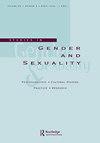女性凝视:《男孩别哭》中的变性人
Q3 Social Sciences
引用次数: 0
摘要
本文将艾丁格的女性主义精神分析运用到金伯利·皮尔斯的标志性电影《男孩不哭》中。虽然许多跨性别研究学者从交叉视角来批评这部电影,但很少有人从女权主义精神分析的角度来探讨与跨性别凝视相关的重要问题。女性主义精神分析理论提供了对凝视、镜子、性别、性别差异、时间性、创伤和记忆的洞察,这些不仅与顺性女性有关,也与跨性别主体有关,而不考虑性别认同。艾丁格对他性差异(OSD)的表述提供了一种理解跨性经验中不可见但对主体性很重要的元素的方法。我认为,在艾丁格所说的母体凝视和跨性别凝视之间存在着一种对应关系,这种对应关系在电影中发挥着作用,它有助于我们理解不可简化为身份的人与人之间的关系。女权主义精神分析理论和跨性别研究不仅关注性别,还关注存在的非视觉元素,这些元素在阳具和白人顺性别代表实践中经常被掩盖。本文章由计算机程序翻译,如有差异,请以英文原文为准。
The Matrixial Gaze: Transgender in Boys Don’t Cry
ABSTRACT This article brings the feminist psychoanalysis of Bracha L. Ettinger to a reading of Kimberley Pierce’s landmark film Boys Don’t Cry. While many transgender studies scholars have critiqued the film from an intersectional lens, few have engaged important questions relevant to a transgender gaze from a feminist psychoanalytic angle. Feminist psychoanalytic theory offers insight into the gaze, the mirror, gender, sexual difference, temporality, trauma, and memory of relevance not only to cisgender women but to transgender subjects irrespective of gender identity. Ettinger’s formulation of the Other Sexual Difference (OSD) provides a way to understand elements of trans- experience that are not visible, yet significant to subjectivity. I contend that there is a correspondence between what Ettinger calls the matrixial gaze and the transgender gaze operating in the film that helps us to understand the interhuman dimensions of looking irreducible to identity. Both feminist psychoanalytic theory and transgender studies are concerned not only with gender but with elements of being that are not ocular and are too often eclipsed in phallic and white cisgender representational practices.
求助全文
通过发布文献求助,成功后即可免费获取论文全文。
去求助
来源期刊

Studies in Gender and Sexuality
Social Sciences-Gender Studies
CiteScore
0.80
自引率
0.00%
发文量
15
期刊介绍:
Beginning in the final two decades of the 20th century, the study of gender and sexuality has been revived from a variety of directions: the traditions of feminist scholarship, postclassical and postmodern psychoanalytic theory, developmental research, and cultural studies have all contributed to renewed fascination with those powerfully formative aspects of subjectivity that fall within the rubric of "gender" and "sexuality." Clinicians, for their part, have returned to gender and sexuality with heightened sensitivity to the role of these constructs in the treatment situation, including the richly variegated ways in which assumptions about gender and sexuality enter into our understandings of "normality" and "pathology."
 求助内容:
求助内容: 应助结果提醒方式:
应助结果提醒方式:


